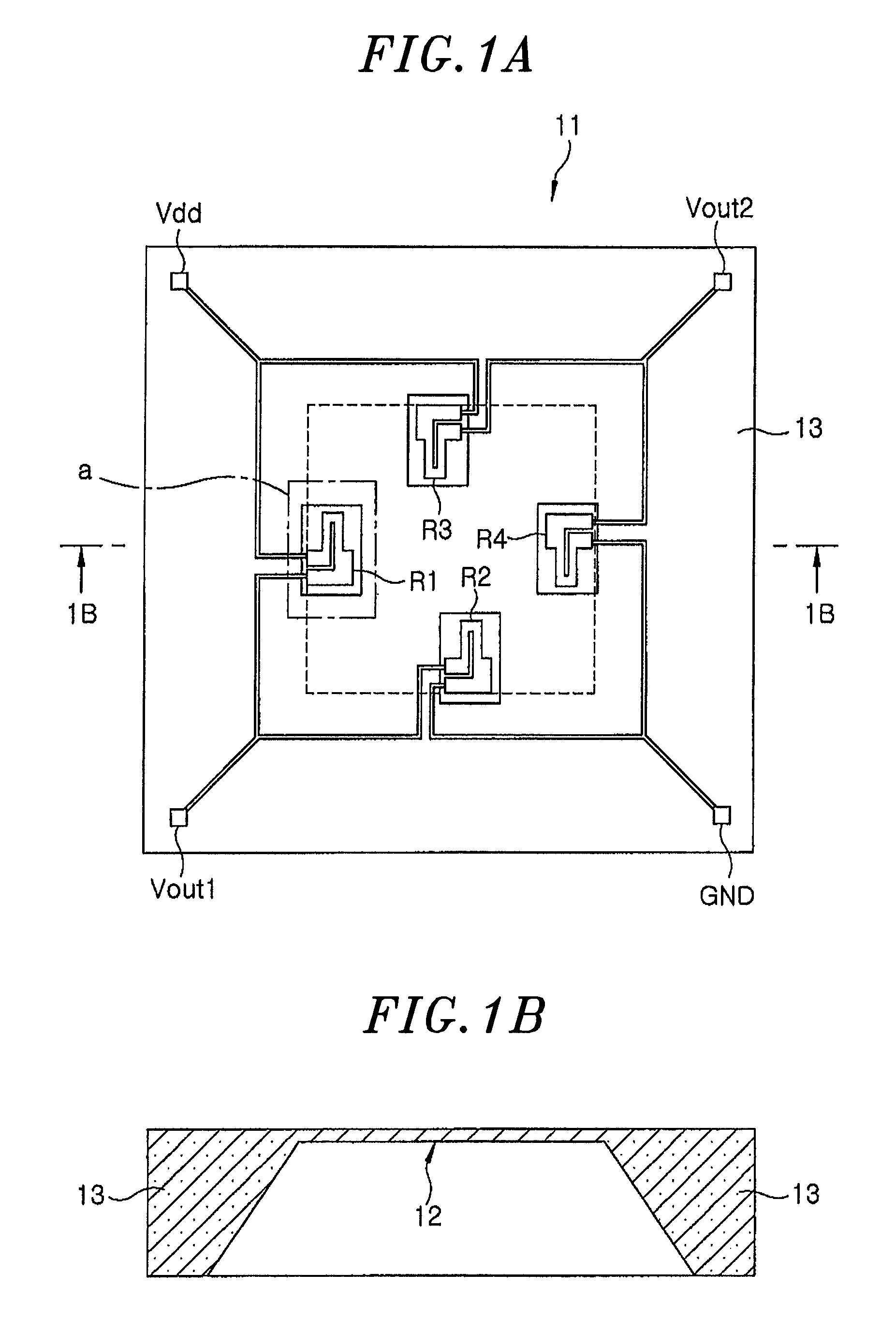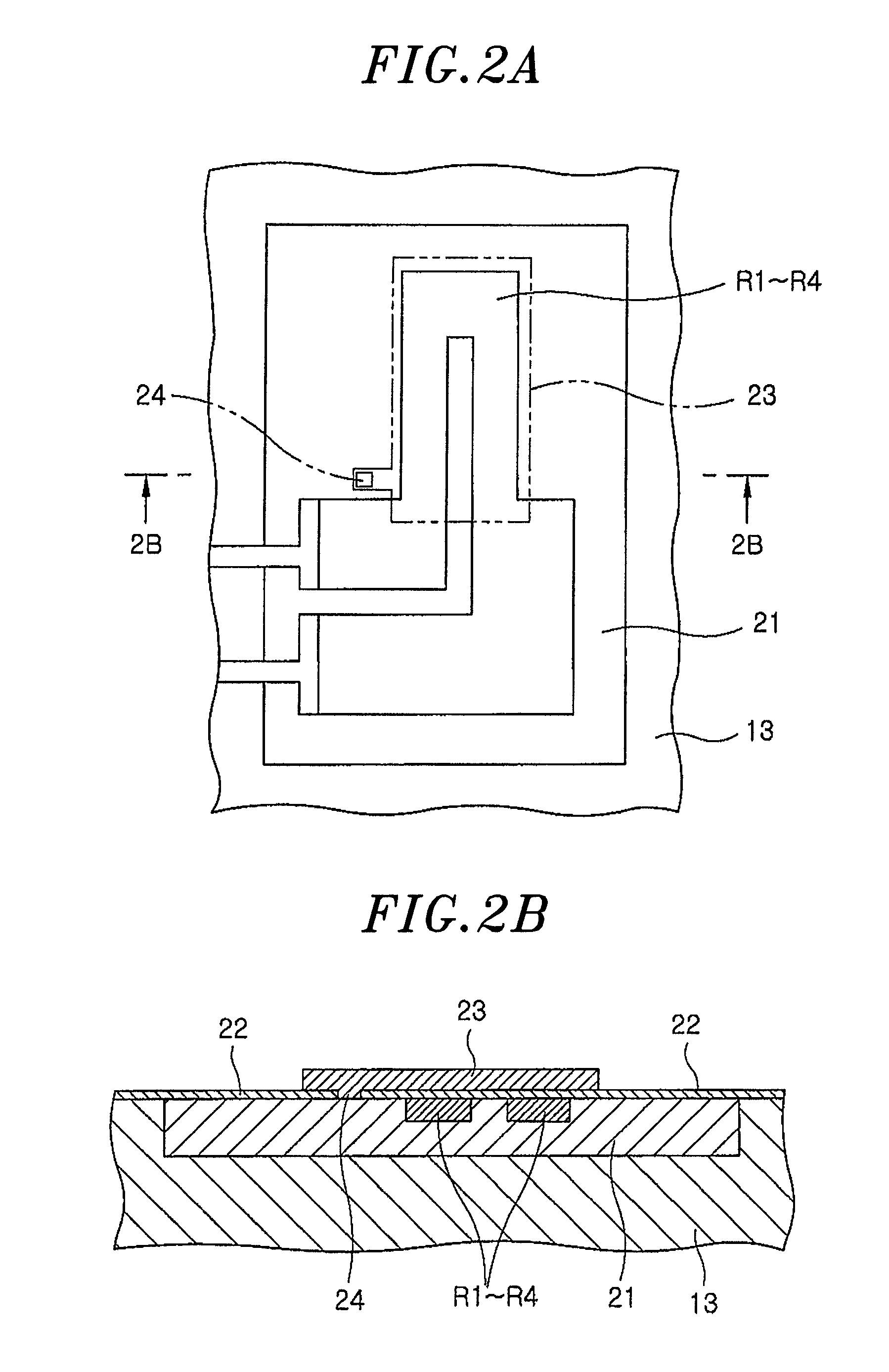Semiconductor pressure sensor
a technology of semiconductors and sensors, applied in the direction of fluid pressure measurement, acceleration measurement using interia forces, instruments, etc., can solve the problems of manufacturing costs, increasing the size of sensors, increasing the number of manufacturing processes, etc., to improve the offset drift and offset voltage of the wheatstone bridge circuit, the effect of simplifying the manufacturing process
- Summary
- Abstract
- Description
- Claims
- Application Information
AI Technical Summary
Benefits of technology
Problems solved by technology
Method used
Image
Examples
first embodiment
[0030]FIGS. 1A and 1B show a configuration of a semiconductor pressure sensor in accordance with a first embodiment of the present invention. FIG. 1A is a plan view of the semiconductor pressure sensor, and FIG. 1B is a cross-sectional view taken along line 1B-1B of FIG. 1A. As shown in FIGS. 1A and 1B, a semiconductor pressure sensor 11 in accordance with the first embodiment of the present invention includes a semiconductor substrate 13 which is made of, e.g., a single crystal silicon substrate and has a thin diaphragm 12 formed in a rectangular shape, and piezoresistive elements R1 to R4 which are respectively formed on a surface region of the semiconductor substrate 13 inside of four side of the diaphragm 12.
[0031]One end of the piezoresistive element R1 is connected to one end of the piezoresistive element R2 through, e.g., a diffusion wiring, and the connection node is connected to an output terminal Vout1 of a Wheatstone bridge circuit to be described below. The other end of ...
second embodiment
[0042]FIG. 4 shows a configuration of a semiconductor pressure sensor in accordance with a second embodiment of the present invention. FIG. 4 corresponds to FIG. 3 of the first embodiment. Since the configuration and arrangement of each of the piezoresistive elements R1 to R4 are the same as those in FIGS. 1A to 2B of the first embodiment, a description thereof will be omitted.
[0043]In contrast to the first embodiment, the second embodiment is characterized in that the n-type semiconductor regions 21 respectively including the piezoresistive elements R1 to R4 are connected commonly to a wiring 41 made of a diffusion layer, a metal or the like, and connected to the high voltage Vdd of the Wheatstone bridge circuit.
[0044]With such configuration, in the second embodiment, it is possible to apply a potential of the high voltage to the shielding thin film layers 23 through the respective n-type semiconductor regions 21. Thus, the potentials of the shielding thin film layers 23 can be sim...
third embodiment
[0045]FIG. 5 shows a configuration of a semiconductor pressure sensor in accordance with a third embodiment of the present invention. FIG. 5 corresponds to FIG. 3 of the first embodiment. Since the configuration and arrangement of each of the piezoresistive elements R1 to R4 are the same as those in FIGS. 1A to 2B of the first embodiment, a description thereof will be omitted.
[0046]In contrast to the first embodiment, the third embodiment is characterized in that the n-type semiconductor regions 21 respectively including the piezoresistive elements R1 and R3, one end of each of which is connected to the high voltage Vdd, are connected to each other through a wiring 51 made of a diffusion layer, a metal or the like. The third embodiment is further characterized in that the n-type semiconductor regions 21 respectively including the piezoresistive elements R2 and R4, one end of each of which is connected to the ground GND, are connected to each other through a wiring 52 made of a diffu...
PUM
| Property | Measurement | Unit |
|---|---|---|
| n-type semiconductor | aaaaa | aaaaa |
| conductive | aaaaa | aaaaa |
| voltage | aaaaa | aaaaa |
Abstract
Description
Claims
Application Information
 Login to View More
Login to View More - R&D
- Intellectual Property
- Life Sciences
- Materials
- Tech Scout
- Unparalleled Data Quality
- Higher Quality Content
- 60% Fewer Hallucinations
Browse by: Latest US Patents, China's latest patents, Technical Efficacy Thesaurus, Application Domain, Technology Topic, Popular Technical Reports.
© 2025 PatSnap. All rights reserved.Legal|Privacy policy|Modern Slavery Act Transparency Statement|Sitemap|About US| Contact US: help@patsnap.com



